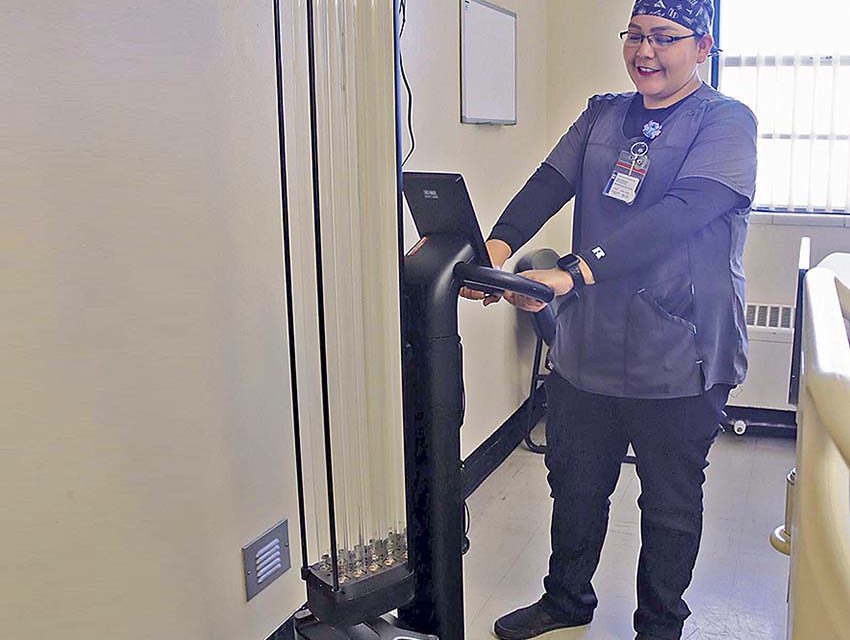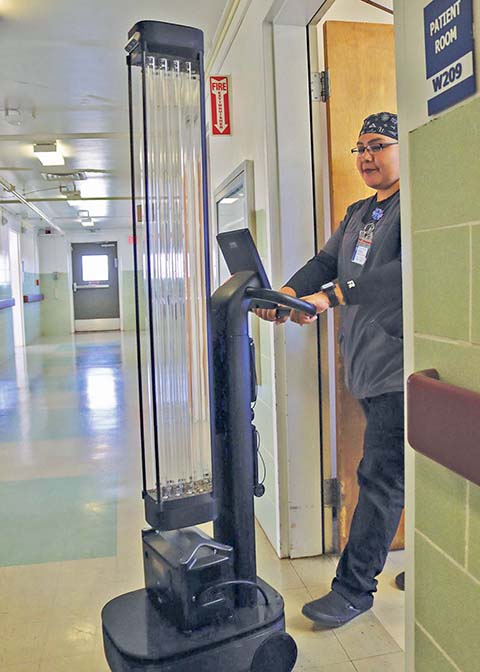
Robots help to ensure maximum cleanliness at hospital

Navajo Times | Boderra Joe
With a handful of research, Sage Memorial Hospital Environment Service Supervisor Tiyarra Wauneka, along with her staff, are proud to obtain three OhmniClean UV disinfect robots to ensure health and safety among patients, visitors, and staff to eliminate bacteria and viruses that linger in areas of the hospital in Ganado, Ariz., on Nov. 28.
GANADO – Three autonomous robots are being used to fight against bacteria and viruses at a local hospital to further ensure the health and safety of patients and staff.
On Feb. 9, Sage Memorial Hospital in Ganado and OhmniLabs, a company based in California, partnered, and signed a contract to provide the hospital with three OhmniClean autonomous UV disinfection robots.

Navajo Times | Boderra Joe
Sage Memorial Hospital Environment Service Supervisor Tiyarra Wauneka walks out of a patient’s room on Nov. 28 in Ganado with one of three OhmniClean UV disinfect robots, which the environmental service staff named “Haséyá.”
The robots arrived at Sage Memorial Hospital on March 21.
During the dark cloud of the pandemic, the Navajo Nation suffered severe rates of the highest per-capita COVID-19 infection rate in the U.S, surpassing New York and New Jersey.
This resulted in having the Navajo Nation’s hospitals re-evaluate their cleaning protocols and like Sage Memorial Hospital they took a big step in investing in UV disinfection robots.
These robots are an autonomous technology and are designed to eliminate 99.9 percent of harmful pathogens, E. coli, and SARS-CoV-2. The robots also allow layers of protection against harmful bacteria, viruses, and hospital-acquired infections (HAIs).
OhmniLabs CEO, Dr. Thuc Vu, explained that the UV disinfection robot helps to maintain cleanliness in healthcare settings and to address the issue of HAIs, which are marginally common infections in hospitals involving medical procedures that involve catheters or ventilators.
Vu said that robots can also reduce labor costs and eliminate the need for harsh chemicals.
According to Vu, Sage Memorial Hospital is the only hospital in the Navajo Nation to have purchased the robots. Gallup Indian Medical Center in Gallup also obtained a fleet of seven OhmniClean robots.
According to Sage Memorial Hospital’s Environment Services Supervisor Tiyarra Wauneka, 28, of Ganado, she said they are hoping to invest in additional robots once they transition to the new hospital, which is currently under construction.
According to Vu, each robot costs roughly $75,000 and has a one-year support and warranty.
Discovering the bots
When COVID-19 first arrived on the Navajo Nation, Sage Memorial Hospital in Ganado, was one of the few facilities that stayed open even as their emergency room filled with positive cases of COVID-19, including their staff.
Wauneka said she and her staff of 17, are first-hand witnesses of the dire need of disinfecting and sanitizing areas. After using electrostatic sprayers to kill bacteria and viruses, Wauneka and her staff felt the need to do more.
As the pandemic continued, Wauneka did thorough research and came across information regarding Gallup Indian Medical Center’s investing in UV robots.
Wauneka reached out to them to learn more, and a meeting was established with GIMC. Wauneka said she was then able to see the robots in action and that GIMC was about to implement them in their facility.
This led Wauneka to learn the ropes of how to operate the robots and understand how to use them. After receiving sufficient training, Wauneka was introduced to the OhmniLabs team and thereafter, created a partnership.
“Robotics are just an additional disinfection process,” Wauneka said. “We want to make sure that a lot of our patients when they would come in because of COVID, they were very hesitant.”
Since patients were hesitant, they slowly let their guard down and began feeling more at ease once they saw a robot doing its job, Wauneka explained.
“We wanted to reach at least 99.9 percent elimination rate, if not higher,” Wauneka said. She mentioned the hospital uses a three-step process and the robot is used as the last step to ensure a thoroughly cleaned area.
“We have our standard clean, then our electrostatic sprayers, and followed by the UV robot,” Wauneka said. “Anything that is left behind that we didn’t get in the first two steps; the UV robots get.”
Effective results
Sharing data is important and Wauneka said they are providing data to OhmniLabs to see how efficient their equipment was working.
“We used ATP testing, adenosine triphosphate, what it does is we will take a swab and we will go over a surface, and it’ll detect how much bacteria is left on that surface and how dirty that surface is,” Wauneka said. “If you wipe the bottom of your shoe that’ll be more dirty than wiping the top of a table.”
A swab is taken of a surface and placed in a luminometer to measure the ATP and a reading of anywhere between zero to a thousand relative light units (RLU) would be considered passing, Wauneka outlined.
“Once we run the UV robots through one cycle, depending on the intensity of the light, we would go back in and do a second swap and then recalculate to see if we were almost at zero or if we were still up in the thousands,” Wauneka said.
From data, she said they would always fall below a hundred once they put their UV robots in the room or area.
“That told us the bacteria that was left behind was actually being eliminated and that is how we were able to see how efficient the UV robots were with our cleaning and disinfection,” Wauneka said.
However, the ATP test does not detect what type of bacteria or virus is present, but rather the number of bacteria that is left.
Blue star rising
According to OhmniLabs, the autonomous robot has user-friendly software to disinfect small to larger areas and the process is simple and effective. The software allows you to map out the area and with its stored cloud memory, you can use it multiple times, including in rooms with a matching layout.
Wauneka said the robots have motion sensors and remote switches to protect anyone from accidental exposure to UV light. For example, if the robot is operating in a room and someone accidentally enters, the robot shuts off. She added that it is easy to transport the robots and they have an instant-swap battery.
Wauneka and her staff use the robots daily in rooms that have high foot traffic such as inpatient care, outpatient care, emergency room, mobile health clinic, wellness center, bathrooms, and touched surfaces: doorknobs, beds, IV stands, and so forth.
“We do use them in office spaces. If we have maybe a staff member contract COVID, then we would also use them in office spaces as well,” Wauneka said.
As leaders in keeping the hospital clean and ensuring safety measures, the environmental services staff named their three robots: Naat’áanii, Sǫ Dootł’izh, and Haséyá.
The purpose of the names reflects the important responsibility of the environmental service staff and the robots – to be leaders with the help of a blue star to rise and to rise out to better serve quality and innovative healthcare.








 Highway 264,
Highway 264, I-40, WB @ Winslow
I-40, WB @ Winslow